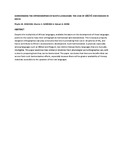| dc.description.abstract | Despite the multiplicity of African languages, available literature on the
development of these languages points to the need to have their
orthographies harmonized and standardised. This is because properly
designed orthographies can play a monumental role in promoting their
use in all spheres of life, and hence contribute to Africa’s socioeconomic
development. Such harmonisation is practical, especially
among languages such as Gĩkŭyŭ and Ekegusii, two distinct Kenyan Bantu
languages that are mutually intelligible. This paper examines how similar
or dissimilar their phonologies and orthographies are, with a view to
proposing how they can be harmonized. The paper concludes that there
are benefits that can accrue from such harmonisation efforts, especially
because there will be greater availability of literacy materials accessible
to the speakers of the two languages. | en_US |


